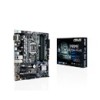Asus PRIME Z270M-PLUS PRIME Z270M-PLUS Users manual ENGLISH - Page 70
Set New Key, Delete Key, Append Key, PK Management
 |
View all Asus PRIME Z270M-PLUS manuals
Add to My Manuals
Save this manual to your list of manuals |
Page 70 highlights
PK Management The Platform Key (PK) locks and secures the firmware from any non-permissible changes. The system verifies the PK before your system enters the OS. Set New Key This item allows you to load the downloaded PK from a USB storage device. The PK file must be formatted as a UEFI variable structure with time-based authenticated variable. Delete Key This item allows you to delete the PK from your system. Once the PK is deleted, all the system's Secure Boot keys will not be active. Configuration options: [Yes] [No] KEK Management The KEK (Key-exchange Key or Key Enrollment Key) manages the Signature database (db) and Revoked Signature database (dbx). Key-exchange Key (KEK) refers to Microsoft® Secure Boot Key-Enrollment Key (KEK). Set New Key Allows you to load the downloaded KEK from a USB storage device. Append Key Allows you to load the additional KEK from a storage device for an additional db and dbx loaded management. Delete Key Allows you to delete the KEK from your system. Configuration options: [Yes] [No] The KEK file must be formatted as a UEFI variable structure with time-based authenticated variable. DB Management The db (Authorized Signature database) lists the signers or images of UEFI applications, operating system loaders, and UEFI drivers that you can load on the single computer. Set New Key Allows you to load the downloaded db from a USB storage device. Append Key Allows you to load the additional db from a storage device so that more images can be loaded securely. Delete Key Allows you to delete the db file from your system. Configuration options: [Yes] [No] • The DB file must be formatted as a UEFI variable structure with time-based authenticated variable. • UEFI executable files include UEFI boot devices, drivers and applications. 2-46 Chapter 2: BIOS Information















